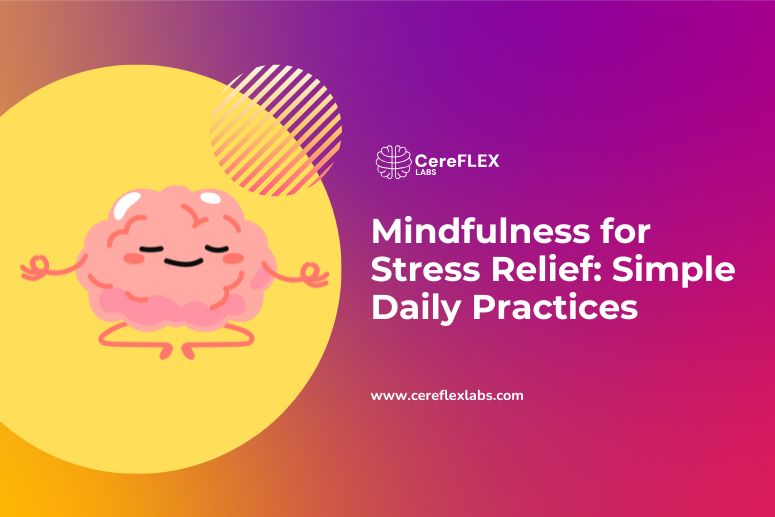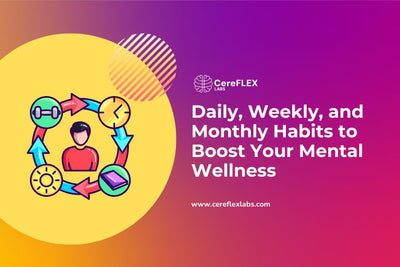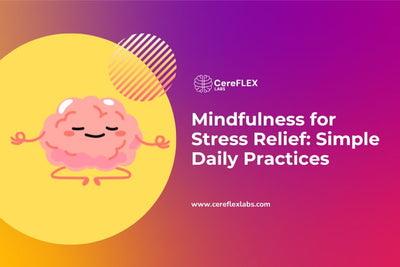Feeling like your thoughts never slow down? Between constant notifications, tight deadlines, and the pressure to stay “on,” stress has become a constant companion for many people.
Mindfulness offers a way to pause and reset. It’s not about escaping life or sitting in silence for hours. It’s about training your attention to be fully present, even in the middle of chaos.
Backed by neuroscience, mindfulness teaches your brain to respond rather than react to stress. Over time, this shift can reduce tension, improve focus, and help you feel more balanced day to day.
In this guide, we’ll break down what mindfulness is, how stress impacts your brain, and share nine simple techniques you can use anytime — no special equipment required.
Here is the Quick Answer |
|
Mindfulness reduces stress by training the brain to stay present without judgment. Simple daily practices—such as mindful breathing, body scans, walking, and intentional eating—calm the nervous system, improve focus, and support emotional balance. Consistent practice builds long-term resilience and better stress response. |
What is mindfulness?
 Mindfulness is the skill of paying attention to the present moment without judgment. It means noticing your thoughts, emotions, and surroundings exactly as they are.
Mindfulness is the skill of paying attention to the present moment without judgment. It means noticing your thoughts, emotions, and surroundings exactly as they are.
It’s not about forcing calm or emptying your mind. Instead, mindfulness is about awareness and acceptance, even when life feels busy or stressful.
The practice has roots in ancient traditions like Buddhism but is now widely used by therapists, neuroscientists, athletes, and business leaders. Why? Because it works. Studies show it can reduce stress, sharpen focus, and build emotional resilience.
Mindfulness isn’t limited to meditation. You can practise it while walking, eating, stretching, or even sipping tea. And you don’t need long sessions. A few mindful breaths can make a noticeable difference.
Most importantly, mindfulness is trainable. Like strengthening a muscle, regular practice makes it easier and more natural over time. With consistency, it becomes part of daily life, helping you respond to stress with clarity instead of reacting automatically.
Science-Backed Effect of Mindfulness on Stress
Mindfulness-based stress reduction (MBSR) is one of the most studied mindfulness programs. It’s been shown to lower stress, anxiety, and depression in many different groups, including healthcare professionals.
A review of 30 studies looked at both standard 8-week MBSR programs and shorter versions. Both worked equally well for reducing stress. Participants also reported better overall psychological well-being.
The benefits likely come from MBSR’s focus on awareness and acceptance, which helps break the cycle of automatic stress reactions.
However, the research also found limits. While MBSR was effective for stress relief, it didn’t always improve burnout or resilience. This means mindfulness works best as part of a broader self-care plan.
Researchers recommend more high-quality studies to fully understand its potential. But for now, the evidence strongly supports mindfulness as a reliable tool for easing stress and improving mental balance.1
Learn more about the benefits of mindfulness for brain health to understand how these practices support focus, memory, and emotional resilience over time.
What are simple mindfulness techniques for stress?
Mindfulness is one of the most effective, research-backed ways to reduce stress. But like physical fitness, it only works if you practice it consistently.
You don’t need special equipment, incense, or a yoga mat. The goal is simply to bring more awareness into your day, even during ordinary activities.
Below are practical ways to weave mindfulness into your routine.

1. Mindful Breathing
Focus on your breath to activate the parasympathetic nervous system — your body’s natural “calm” mode.
Inhale into your belly, ribs, and chest. Then exhale slowly.
If your mind drifts, gently return to the breath without judgment. Just a few minutes can make a difference.
2. Body Scan & Mindful Stretching
Bring awareness to each part of your body, from head to toe.
Notice areas of tension. Pair this with gentle stretches, matching your inhale and exhale for equal counts.
Rather than forcing movement, allow space for relaxation with each breath.
3. Meditative or Core Walking
 Walk slowly, paying attention to the shifting of your weight, the swing of your arms, and the feel of the air.
Walk slowly, paying attention to the shifting of your weight, the swing of your arms, and the feel of the air.
This helps ground you in the present while engaging muscles that support balance and posture.
4. Hiking & Connecting with Nature
Nature stimulates the senses and calms the nervous system.
Notice the sound of leaves, the scent of fresh air, or the warmth of the sun. Even 10 minutes outdoors can reset your mood.
5. Swimming or Floating in Water
Water supports the body and creates a natural rhythm with your breath.
Swimming engages the whole body, while floating lets you focus on the gentle rise and fall of your breath.
6. Drinking a Cup of Tea

Turn tea (or any warm drink) into a mindful ritual.
Pay attention to its aroma, warmth, and texture. Focus on each sip instead of rushing through the moment.
7. Mindful Eating
Before your first bite, pause and take a breath.
Notice textures, flavours, and hunger cues. Eating slowly supports digestion and helps you stay present.
8. Guided Meditation

If silence feels challenging, try a guided meditation via apps like Headspace, Insight Timer, or YouTube.
Even 5–10 minutes can reduce stress and improve focus.
9. Gazing Meditation
Soften your gaze on a fixed point: a candle flame, horizon, or campfire.
Let your focus drift back to that point whenever your thoughts wander.
How to Build a Daily Mindfulness Habit
Mindfulness works best when it’s part of your everyday life, not just something you do when stress peaks. The key is to start small, stay consistent, and make it easy to remember.
Pair it with Daily Tasks (Habit Stacking)
Link mindfulness to habits you already have.
Practice mindful breathing while brushing your teeth.
Notice your posture and body sensations while stretching before a shower.
Take three slow breaths before starting your car.
Start Small
Don’t aim for 20 minutes on your first day. Begin with 1–2 minutes of focused breathing or awareness.
Your goal isn’t perfection. It’s consistency. Small, manageable steps are easier to sustain.
Use Reminders to Stay on Track
Set subtle cues such as a phone alarm, a sticky note, or a candle at your desk.
These gentle prompts bring you back to the present moment throughout the day.
Keep a Short Mindfulness Journal

Write a sentence or two about your practice each day.
Example: “I felt calmer after walking without my phone.”
Reflection reinforces the habit and reminds you why it’s worth continuing.
Focus on Consistency, Not Intensity
Two mindful minutes every day is better than one long session followed by a week off.
Over time, your brain will start to expect and crave these moments of presence.
Is It Working? Signs Mindfulness Is Helping
Mindfulness often works in subtle ways. You may not notice big changes overnight, but small shifts can signal progress.
Increased Awareness
You notice thoughts, emotions, and physical sensations as they arise, instead of running on autopilot.
Improved Response to Stress
When something challenging happens, you pause, breathe, and respond with more clarity instead of reacting impulsively.
Better Sleep, Focus, and Mood
You fall asleep more easily, concentrate for longer, and feel less emotionally overwhelmed during the day.
Less Reactivity to Challenges
Situations that once triggered frustration or anxiety don’t affect you as strongly.
You may still feel them, but you recover faster without spiraling.
When to Seek Professional Support
Mindfulness can make a big difference in daily stress management, but it’s not always enough on its own. Pairing it with other forms of support can strengthen your brain’s resilience and focus.
You may benefit from professional help if:
- Stress, fatigue, or overwhelm continue despite regular mindfulness practice
- Focus, memory, or energy feel consistently low
- Sleep problems or emotional ups and downs persist
- You want a structured, guided approach to cognitive wellness
At Cereflex Labs, we offer support alongside your mindfulness routine: the AM/PM Protocol—a two-part supplement system designed to support brain health from morning to night.
- AM Formula: Supports cognition, source of antioxidants, multi-vitamin and multi-mineral support, helps protect cells against damage caused by free radicals.
- PM Formula: Enhances cognitive function, enhances memory, source of antioxidants, supports peripheral circulation, and helps protect cells against damage caused by free radicals.
➤ Important: Always consult a healthcare professional before starting new supplements or wellness programs, especially if you have health conditions or take medication.
Conclusion
Mindfulness doesn’t require a silent retreat or hours of meditation.
It can start with a single breath, a slow sip of tea, or a short walk without your phone.
These small, intentional moments help your mind shift from reactive to resilient. Over time, they add up, building mental clarity, emotional balance, and a greater sense of presence in daily life.
If you’re managing stress or simply want to feel more grounded, remember:
- The key is consistency, not perfection.
- Distractions are normal. What matters is returning to the present without judgment.
And if you ever feel like mindfulness alone isn’t enough, Cereflex Labs offers science-informed tools and personalized support to help you sustain your mental wellness from the inside out.
Start small.
Stay present.
Let your practice grow.






